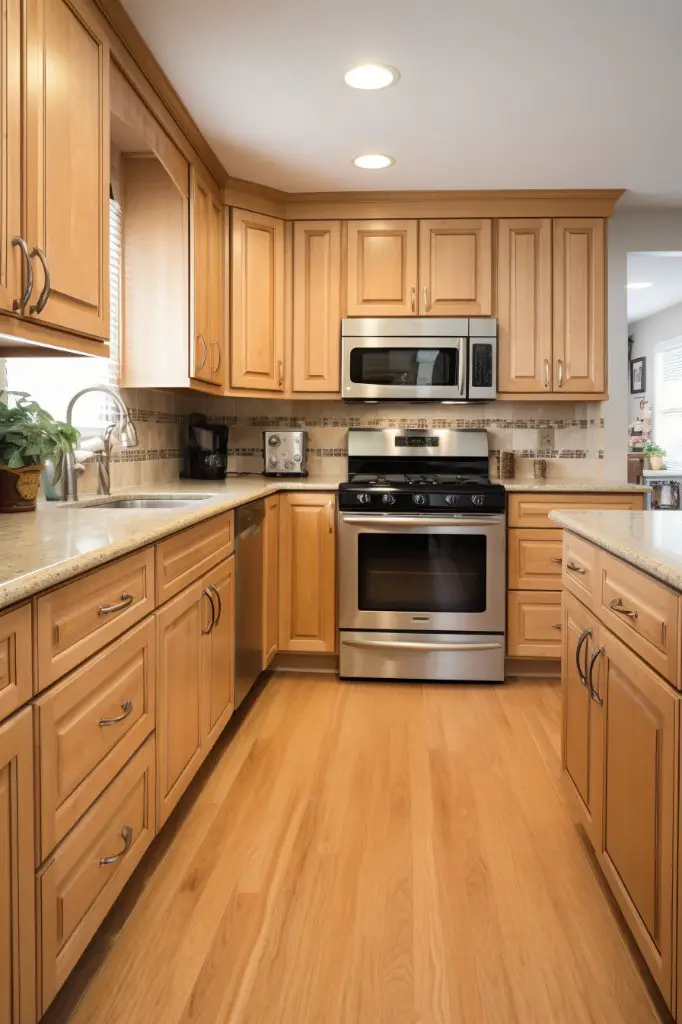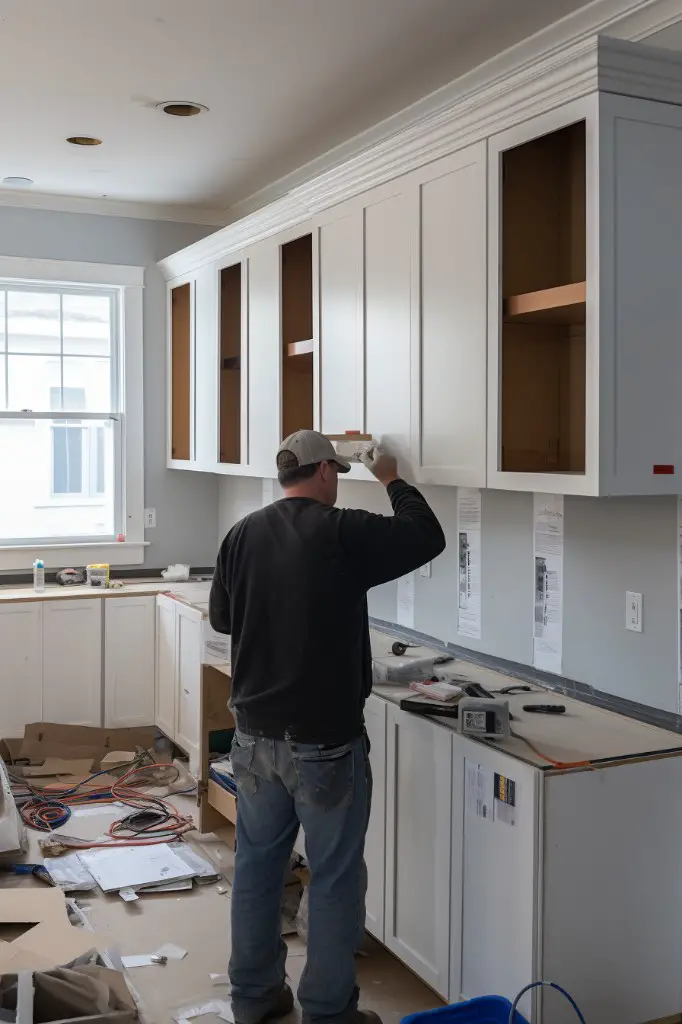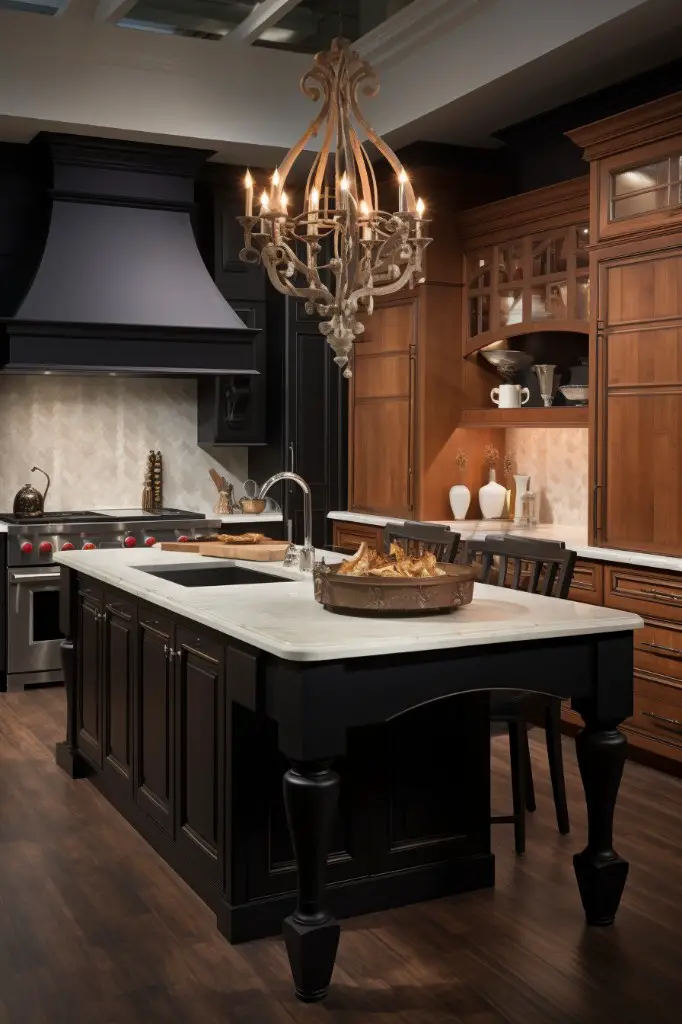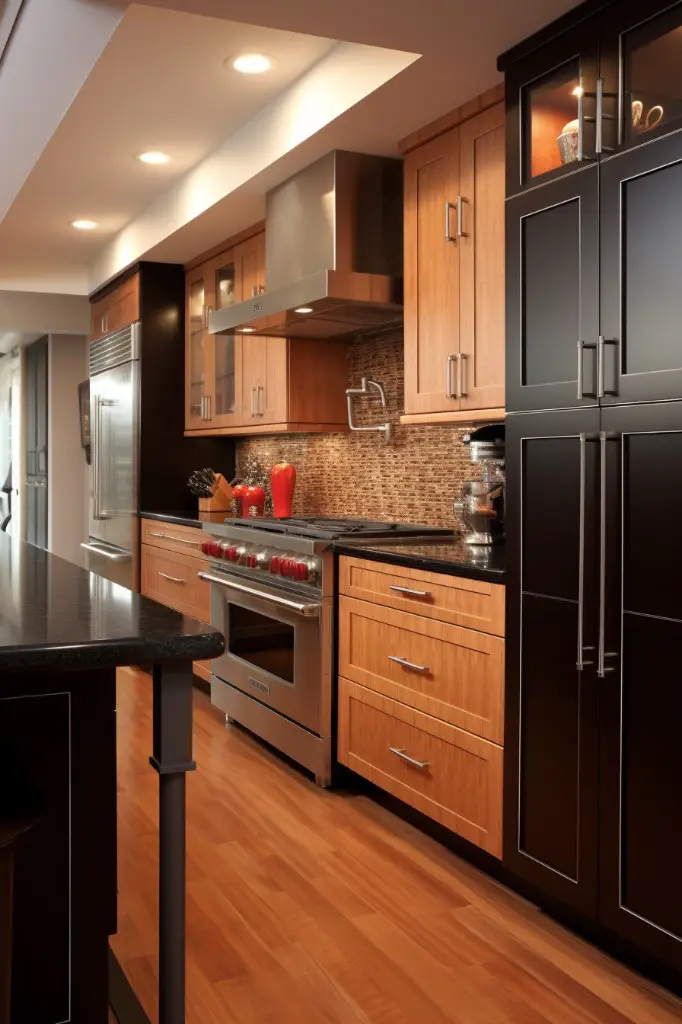Last updated on
Discover the duration of a kitchen cabinet replacement project as we dive into factors that influence the timeline in this informative blog post.
Are you planning to give your kitchen a fresh new look by replacing the cabinets? It’s a great idea! Kitchen cabinets play a significant role in enhancing the overall appearance of your kitchen. However, before you start ripping out the old ones, it’s essential to know how long it will take to replace them.
The time frame for replacing kitchen cabinets can vary depending on several factors. In this article, we’ll dive into all the details and help you understand how long it takes to replace kitchen cabinets so that you can plan accordingly and make informed decisions.
What's Inside
Assessing Kitchen Cabinet Needs

Before you start the process of replacing your kitchen cabinets, it’s essential to assess your needs. Consider what you want to achieve with the new cabinets and how they will fit into your overall kitchen design.
Do you need more storage space? Are there any specific features that are important to you, such as soft-close drawers or pull-out shelves? Assessing these needs will help guide decisions on cabinet style and materials.
Another factor to consider is whether or not the current layout of your kitchen works for you. If not, this may be an opportunity for a complete redesign of the space rather than just a simple cabinet replacement project.
In this case, working with a professional designer can be helpful in creating an efficient and functional layout that meets all of your needs.
Assessing Kitchen Size

If you have a small kitchen, it may take less time to replace the cabinets than if you have a larger one. A smaller space means fewer cabinets and less work for installation professionals or DIYers.
On the other hand, if you have a large kitchen with many cabinets and features such as islands or peninsulas, it will take more time to complete the project. Larger kitchens often require custom cabinetry solutions that can add extra days or weeks to your timeline.
Choosing the Right Cabinet Style

The style you choose should complement your kitchen’s overall design and reflect your personal taste. There are several cabinet styles to choose from, including traditional, modern, rustic, shaker-style cabinets and more.
Traditional cabinets feature ornate details such as raised panels or decorative moldings that give them a classic look. Modern cabinets have sleek lines with minimal ornamentation for a clean and contemporary feel.
Rustic-style cabinetry has an aged appearance with distressed finishes that add character to any space.
Shaker-style cabinetry is one of the most popular choices among homeowners due to its simple yet elegant design featuring flat-panel doors with rail frames.
Selecting Cabinet Materials

The material you choose will not only impact the overall look of your kitchen but also its durability and maintenance requirements.
Wood is a popular choice for cabinets as it offers a classic and timeless look. However, wood can be expensive, so if you’re on a budget, consider MDF or particleboard with veneer finishes that mimic natural wood grains.
If you want something more durable than wood or MDF, metal cabinets may be an option worth considering. Metal cabinets offer excellent resistance to moisture and heat damage while providing an industrial aesthetic appeal.
Another option is laminate cabinetry which provides versatility in terms of color choices and patterns at affordable prices compared to other materials like solid surface countertops or quartz surfaces that can cost thousands per square foot!
Custom Cabinets Vs. Stock Cabinets
Custom cabinets are built specifically for your kitchen and offer a unique design that fits your style and needs. On the other hand, stock cabinets come pre-made in standard sizes and designs.
Custom cabinetry takes longer to build than stock cabinetry because they require more time for planning, designing, building, finishing touches such as priming or painting before installation can begin. Stock cabinet installations are quicker since they’re already made; however, their limited size options may not fit all kitchens’ dimensions.
Choosing between custom vs. Stock depends on several factors like budget constraints and personal preferences regarding aesthetics or functionality requirements of the space being renovated.
If you have a tight budget but still want quality materials with an attractive finish that will last long-term use without breaking down quickly due to wear-and-tear from daily usage – then choosing pre-built units might be best suited for you.
Budgeting for Cabinet Replacement
It’s crucial to determine how much you’re willing to spend before embarking on the process. The cost of replacing kitchen cabinets can vary depending on several factors, such as materials, size, and style.
To create a budget for your cabinet replacement project, start by assessing your needs and determining what type of cabinets you want. Custom-made cabinets are more expensive than stock ones but offer greater flexibility in terms of design options.
Next, consider the material used in making the cabinets; hardwoods like oak or maple are more expensive than particleboard or MDF (medium-density fiberboard). Hardware such as handles and knobs can add up quickly if not factored into your budget from the beginning.
Decide whether you’ll hire a professional contractor or do it yourself (DIY). While DIY projects may seem cheaper at first glance because they don’t include labor costs upfront – there may be hidden expenses that arise during installation that could end up costing even more money down-the-line!
Hiring a Professional Vs. DIY
While DIY projects can be fun and cost-effective, they may not always be the best option for everyone. Replacing kitchen cabinets requires skills, experience, and specialized tools that many homeowners may not have.
If you’re considering doing it yourself, ask yourself if you have enough time to complete the project from start to finish without interruptions. Also consider if you possess all necessary tools required for cabinet installation such as saws and drills.
On the other hand, hiring professionals will save time while ensuring quality workmanship with minimal errors during installation. Professionals also come equipped with all necessary equipment needed for cabinet replacement which saves money on tool rentals or purchases.
Planning and Designing Your Kitchen Cabinets
This step is crucial as it sets the foundation for a successful replacement project. You can either work with a professional designer or take on this task yourself if you’re confident in your design skills.
When planning and designing your kitchen cabinets, consider factors such as functionality, storage space requirements, style preferences that match the rest of your home decor scheme. Think about how often you cook or entertain guests in the kitchen to determine what features will be most useful.
You’ll also need to decide on materials such as wood type (if applicable), finish options like paint or stain color choices that complement other elements within the room like flooring tiles backsplash etc., hardware selection including knobs pulls hinges etc., lighting fixtures placement which can make all difference when cooking at night!
Collaboration With a Designer
A designer will work closely with you to understand the style and functionality requirements for your space. They’ll also take into account any unique features or challenges that may impact the cabinet installation process.
During this collaboration, it’s essential to communicate openly about what you want from the project so that everyone is on the same page. Be sure to share any inspiration photos or ideas you have for cabinet styles, colors, finishes, hardware options as well as storage solutions.
Working alongside an experienced designer can save time by streamlining decision-making processes while ensuring quality results at every stage of construction and installation. They can provide valuable insights into materials selection based on their experience working within different budgets.
Measuring and Ordering New Cabinets
Measuring accurately is crucial to ensure that your new cabinets fit perfectly in your kitchen space. You can either take measurements yourself or hire a professional to do it for you.
When measuring, be sure to account for any irregularities in the walls or floors of your kitchen. It’s also essential to consider the placement of appliances such as refrigerators, ovens, and dishwashers when taking measurements.
After measuring, you’ll need to order the cabinets from a manufacturer or supplier. Be sure that all details are correct before placing an order because mistakes can cause delays in delivery times.
It’s important not only to get accurate measurements but also choose high-quality cabinetry from reputable manufacturers who offer warranties on their products. This will help ensure that you receive durable and long-lasting cabinetry that meets both aesthetic requirements as well as functional needs while staying within budget constraints.
Scheduling Installation and Final Inspection
The duration of this process can vary depending on the size and complexity of your kitchen. If you’re hiring a professional installer, they will provide an estimated timeline for completion based on their experience and expertise.
It’s important to note that scheduling installation should be done in advance as most contractors are usually booked weeks or even months ahead. Therefore, plan accordingly so that you don’t end up with a half-finished kitchen for longer than necessary.
After the installation is complete, there will be a final inspection to ensure everything has been installed correctly and meets all safety standards. This step is crucial because any mistakes made during installation could lead to costly repairs down the line.
During this inspection phase, make sure all appliances are working correctly and that there are no leaks or damages caused by improper cabinet installations.
Preparing Your Kitchen for Cabinet Work
Preparing your kitchen will help ensure a smooth and efficient installation process. Here are some things you can do to get started:
Firstly, remove all items from inside your cabinets and drawers. This includes dishes, utensils, pots and pans or any other items stored in them.
Next up is clearing out countertops of appliances such as microwaves or coffee makers that may be in the way during installation.
You should also consider removing any wall hangings like pictures or clocks near where new cabinets will be installed so they don’t get damaged during construction.
Lastly but not least important is covering floors with drop cloths to protect them from scratches caused by tools used during cabinet removal/installation processes.
Removal of Old Cabinets
The first step in replacing your kitchen cabinets is removing the old ones. This can be a challenging task that requires careful planning and execution.
Before starting any work, make sure to prepare your kitchen by clearing out all items from inside the cabinets as well as on top of them. You’ll also need to turn off power sources such as electrical outlets or switches near where you will be working.
To remove old cabinets, begin by unscrewing them from their frames using a drill or screwdriver. Be sure to wear gloves during this process since there may be sharp edges or splinters that could cause injury.
Once all screws are removed, gently pull each cabinet away from its frame until it comes loose completely. If necessary, use a pry bar or hammer with caution if they are glued in place.
Building and Installing New Cabinets
This process can take anywhere from a few days to several weeks, depending on the size of your kitchen and complexity of the design.
If you are working with a professional contractor or carpenter, they will typically handle this step for you. They will measure your space precisely before building custom cabinets that fit perfectly in your kitchen.
Once built, they’ll install them carefully while ensuring everything is levelled correctly.
If you’re taking on this project yourself as a DIYer, there are many resources available online that provide detailed instructions for building and installing new cabinets. You’ll need some basic woodworking skills along with tools such as saws, drills etc., but it’s definitely doable if you’re up for the challenge!
Remember to take accurate measurements before starting any construction work so that everything fits together seamlessly once installed in place.
Installing Appliances and Countertops
This step can take anywhere from a few hours to several days depending on the number of appliances you have and their complexity. If you’re replacing your old kitchen with new ones, make sure that all electrical outlets and plumbing connections are in place before installing any appliance.
When it comes to countertops, there is an array of options available in terms of materials such as granite, marble or quartz. The installation process for each material varies but typically involves measuring the countertop area accurately before cutting it into shape using specialized tools.
It’s important not only to choose a countertop that complements your cabinet style but also one that suits your lifestyle needs. For example, if you love cooking frequently or hosting dinner parties regularly then choosing a durable material like granite would be ideal as they can withstand high heat levels without getting damaged easily.
Installing New Cabinet Hardware
One of the most important aspects of cabinet installation is choosing and installing hardware. Cabinet hardware includes knobs, pulls, hinges, and other accessories that help open and close doors or drawers.
When selecting cabinet hardware for your newly installed cabinets, consider factors such as style preference and functionality. You want to choose a design that complements your overall kitchen decor while also being easy to use.
Installing new cabinet hardware is relatively simple if you have basic DIY skills. However, it can be time-consuming if you’re doing it yourself since each piece needs individual attention during installation.
If hiring a professional installer for your cabinetry project they may offer additional services like drilling holes in the right places so all handles are levelled correctly or ensuring all screws are tightened properly before leaving site which could save some headaches down the line!
Adding Kitchen Features and Accessories
Adding new features and accessories can be a fun way to personalize your kitchen while also making it more efficient. Some popular additions include pull-out shelves, lazy susans, spice racks, utensil organizers, and built-in cutting boards.
These items not only make cooking easier but also help keep everything organized.
Another great feature is under-cabinet lighting which illuminates the countertop workspace for better visibility when preparing meals or entertaining guests in the evening hours.
If you have extra space in your kitchen after replacing cabinets or are looking for ways to maximize storage capacity further; consider adding a pantry cabinet with adjustable shelving units that allow you to store food items efficiently.
Finishing Touches, Priming, and Clean-Up
This includes priming and painting or staining the cabinets to match your kitchen decor. It’s essential to let them dry completely before adding any hardware or accessories.
After completing all of these steps, you’ll need to clean up your kitchen thoroughly. Removing debris and dust from every corner is crucial for a successful cabinet replacement project.
It’s important not only for aesthetic reasons but also because leftover debris can cause damage over time if left unattended.
Time Frame for DIY Cabinet Replacement
The size of your kitchen, the complexity of the project, and your level of experience with DIY projects are some key factors that will influence how long it takes.
On average, a DIY cabinet replacement project can take anywhere from one weekend to several weeks. If you have a small kitchen and choose pre-assembled stock cabinets that fit perfectly into place without any modifications or adjustments needed, then replacing them could be done in just one weekend.
However, if you have a larger kitchen or want custom-made cabinets built from scratch using high-end materials like hardwoods or exotic woods such as bamboo or teak wood – this type of project may require more time than usual due to its complexity.
Time Frame for Professional Installation
The size of your kitchen, the complexity of the project, and any unforeseen issues that arise during installation can all affect how long it takes to complete. On average, a professional cabinet replacement project can take anywhere from 2-4 weeks.
The first step in determining how long it will take is scheduling an initial consultation with a contractor or designer. During this meeting, they’ll assess your needs and provide an estimate for both cost and timeline.
Once you’ve agreed on design plans and materials selection with your contractor or designer comes measuring up space for new cabinets before ordering them from manufacturers which usually takes about two weeks depending on availability.
After receiving delivery of new cabinets at home comes removal of old ones which may take one day then building/installing new ones could last between three days to two weeks depending again upon complexity involved in installing appliances/countertops as well as adding features/accessories such as lighting fixtures etcetera.
Finally finishing touches like priming walls/cabinets followed by clean-up are done before final inspection is carried out by professionals who ensure everything has been installed correctly according to plan so that homeowners get their dream kitchens without any hassle!
FAQ
How long should it take to install new kitchen cabinets?
The time to install new kitchen cabinets varies from 1-2 days for smaller kitchens to up to 14 days or more for larger spaces, with an average timeframe of 5 to 14 days.
How long does it take for home Depot to install cabinets?
Home Depot typically takes about a week to install cabinets, but if you order custom or semi-custom cabinets, the process can take 4-12 weeks for manufacturing and delivery.
Do you have to replace countertops when replacing cabinets?
No, you don’t have to replace countertops when replacing cabinets if they are still in good condition.
Can you replace kitchen cabinets one at a time?
Yes, you can replace kitchen cabinets one at a time to achieve a remodeled feel without removing the entire set.
What is the average cost of replacing kitchen cabinets?
The average cost of replacing kitchen cabinets is about $4,000 to $9,000, depending on various factors like the size of the kitchen, materials, and installation fees.
What factors can affect the duration of a kitchen cabinet replacement project?
Factors affecting the duration of a kitchen cabinet replacement project include contractor availability, cabinet materials, complexity of the design, and potential unforeseen complications.
What are the essential steps to prepare for a kitchen cabinet installation?
The essential steps for a kitchen cabinet installation include measuring and marking the wall, preparing the cabinet area, leveling and securing the cabinets, and attaching hardware and doors.




